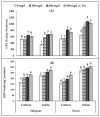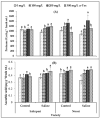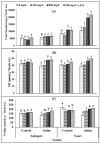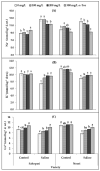Foliar Spray of Alpha-Tocopherol Modulates Antioxidant Potential of Okra Fruit under Salt Stress
- PMID: 34371585
- PMCID: PMC8309244
- DOI: 10.3390/plants10071382
Foliar Spray of Alpha-Tocopherol Modulates Antioxidant Potential of Okra Fruit under Salt Stress
Abstract
As an antioxidant, alpha-tocopherol (α-Toc) protects plants from salinity-induced oxidative bursts. This study was conducted twice to determine the effect of α-Toc as a foliar spray (at 0 (no spray), 100, 200, and 300 mg L-1) to improve the yield and biochemical constituents of fresh green capsules of okra (Abelmoschus esculentus L. Moench) under salt stress (0 and 100 mM). Salt stress significantly reduced K+ and Ca2+ ion concentration and yield, whereas it increased H2O2, malondialdehyde (MDA), Na+, glycine betaine (GB), total free proline, total phenolics, and the activities of catalase (CAT), guaiacol peroxidase (GPX), and protease in both okra varieties (Noori and Sabzpari). Foliar application of α-Toc significantly improved the yield in tested okra varieties by increasing the activity of antioxidants (CAT, GPX, SOD, and ascorbic acid), accumulation of GB, and total free proline in fruit tissues under saline and non-saline conditions. Moreover, α-Toc application as a foliar spray alleviated the adverse effects of salt stress by reducing Na+ concentration, MDA, and H2O2 levels and improving the uptake of K+ and Ca2+. Among the tested okra varieties, Noori performed better than Sabzpari across all physio-biochemical attributes. Of all the foliar-applied α-Toc levels, 200 mg L-1 and 300 mg L-1 were more effective in the amelioration of salinity-induced adverse effects in okra. Thus, we concluded that higher levels of α-Toc (200 mg L-1 and 300 mg L-1) combat salinity stress more effectively by boosting the antioxidant potential of okra plants.
Keywords: alpha-tocopherol; antioxidants; foliar spray; okra varieties; salinity.
Conflict of interest statement
The authors declare that they have no conflict of interest.
Figures







References
-
- Temam N., Mohammed W., Aklilu S., Belayneh A.H., Gebremedhin K.G., Egziabher Y.G. Variability Assessment of Okra (Abelmoschus esculentus (L.) Moench) Genotypes Based on Their Qualitative Traits. Int. J. Agron. 2021;2021:6678561. doi: 10.1155/2021/6678561. - DOI
-
- Haruna S., Aliyu B.S., Bala A. Plant gum exudates (Karau) and mucilages, their biological sources, properties, uses and potential applications: A review. Bayero J. Pure Appl. Sci. 2016;9:159–165. doi: 10.4314/bajopas.v9i2.30. - DOI
-
- Mushtaq N.U., Saleem S., Rasool A., Shah W.H., Hakeem K.R., Rehman R.U. Salt Stress Threshold in Millets: Perspective on Cultivation on Marginal Lands for Biomass. Phyton. 2020;90:51. doi: 10.32604/phyton.2020.012163. - DOI
-
- Mushtaq Z., Faizan S., Gulzar B. Salt stress, its impacts on plants and the strategies plants are employing against it: A review. J. Appl. Biol. Biotechnol. 2020;8:81–91.
Grants and funding
LinkOut - more resources
Full Text Sources
Research Materials
Miscellaneous

